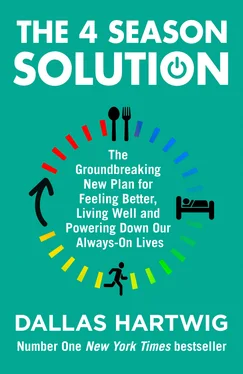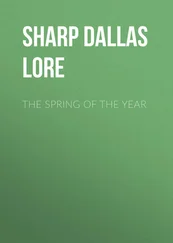As I knew firsthand, there isn’t just one particular change or even a series of discrete changes you can make to achieve optimum health. Living better is an ongoing and never-ending process of behavior change, all grounded in your ability to cue into your body and its rhythmic needs. What was needed, I thought, was a book that presented the larger framework for rhythmically based living, so that others could do what I did: move yourself toward better health by changing your behaviors in a way and at a pace that feels right for you.
Unlike The Whole30 , which offers a highly structured, tightly constrained program for people to follow, The 4 Season Solution presents a conceptual road map to explore your own body and health… and life! It helps you rethink your health habits from an ancestral and biological standpoint so that you can then reshape them. Who knows where you’ll start—or where you’ll go—as you learn how our bodies have evolved to function, how we’re failing to effectively meet our body’s most basic needs, and how our health gets compromised as a result. One thing I do know: the more you learn, and the more you experiment, the more you’ll want to learn and experiment. That’s because this book prompts you to consult the greatest health expert of all, and one who is most routinely neglected—you. I know a lot about how human bodies work, but I don’t know what’s best for your body. That’s for you to discover and for you to champion.
Although we might have fallen out of touch with our natural rhythms, all of us intuitively know what our bodies need. We have just become habituated to ignore the urges inside us that would cue us to sleep, eat, move, and connect in certain ways at certain times of the day or year. With our intuition consistently ignored and underdeveloped, we rely almost exclusively on our rational selves—and our willpower—to adopt and stick with healthy behaviors. But willpower alone doesn’t usually help us stick with health regimens. We all have a limited supply of willpower, and all too frequently, the tank runs empty because we are using it to deal with annoying coworkers, traffic, tempting treats, and strained relationships with friends or partners. Plus, mustering up willpower all the time is hard. Your intuition is the path to a healthier, saner, happier, calmer, and more fulfilling life, all with progressively less brute effort on your part.
This is not to say that syncing your body with natural rhythms will always be easy. It won’t. If you travel every week for your job, sitting for many hours on planes or in cars, you might have some ability to pay more respect to your bodily rhythms, but ultimately, achieving better health might require that you change your life so that you travel less. If you eat pizza multiple times a week because it’s cheap and convenient, you might have to spend more on food to improve your diet. You don’t have to be independently wealthy to live a healthy life, but you do have to recalibrate how you live, as well as allocate your time and money in ways that echo your personal values in order to respect your body’s evolutionary needs. This might mean cutting back on impulsive shopping or getting a cheaper cable TV plan so that you can afford higher-quality, locally produced, organic food. Or it might mean asking your boss to adjust your work schedule seasonally so that you can more closely follow your body’s natural sleep rhythms. The point is to become more aware of your rhythms, so that you can understand the impact of your daily behaviors and make conscious decisions about how you live and the level of health you enjoy. Small, sustainable changes in your behavior lead you to better health over months, years, and ultimately, a lifetime. The key is simply to get started somewhere with an experiment of your choosing.
I’ve organized this book to make it as easy as possible to understand our premodern bodies and to try on new behaviors. The first chapter builds on the behavioral theory of health I’ve sketched out, detailing several key concepts that will help us understand our collective and problematic disconnection from our bodies. The following four chapters present my model, arguing that for optimal human health the four basic needs—sleep, food, movement, meaningful connection—must align with one another, and that they must oscillate. I’ve used the phrase “coordinate then oscillate” to succinctly express how to bring these four areas of health behaviors back into harmony with each other. Match, then move. Each of these chapters draws on the latest science to examine our bodies’ natural patterns in one of these areas. Comparing these patterns with the demands of modern life, I identify areas of mismatch and explain how they lead to dysfunction, disease, and a general feeling of being “stuck.” Chapters 6
, 7
, and 8
explore how our natural rhythms in the four areas interact during the course of three time periods, respectively: the day, the year, and your entire lifetime. Here I’ll help you assess where your daily habits might be going astray from your body’s needs, and I’ll suggest some behavior change experiments to try. I’ll close the book by evoking the “endgame” that long-term dedication can yield: a life of deeper peace, enrichment, and fulfillment beyond the usual bodily cravings that occupy us.
My own health has improved dramatically since I started realigning my behaviors and habits with my internal rhythms. After a decade of experimenting, I understand that my previous ways of sleeping, eating, moving, and connecting left a lot to be desired. At certain times of the year, I now spend less time exercising and more time sleeping. At all times, I eat food seasonally that helps support my exercise program. I’ve become adept at slowing down and turning inward at certain times, and accelerating and expanding outward at others. Best of all, I’ve learned to apply rhythmic principles to my social relationships. That means, for example, that I don’t throw myself headlong into “holiday party season,” since the intense stimulation of parties with coworkers or friends is at odds with our natural autumnal desire to hunker down for the coming winter, to withdraw, to rest. When healing after a painful divorce, I took solace in an extended, symbolic winter season, using it to introspect, develop my self-awareness, and restore my sapped energy.
I’ve also put sensible limits on my social media use and our always-on culture. While I maintain a large and growing social media following, and enjoy interacting with followers all over the world, I now spend more time connecting deeply with just a few close friends and family members, as well as with myself. My social way of being varies seasonally as well, with more boisterous social engagements in the summertime, and far fewer in the winter. My life is far more satisfying and, in all senses of the word, healthier.
Just as Abraham Maslow’s hierarchy of needs would imply, healthier tends to beget happier. Meeting foundational needs such as enough nourishing food and proper synchronization with intrinsic circadian rhythms allows humans to spontaneously and meaningfully address other, higher-order needs, such as those of cognitive and emotional growth, appreciation of beauty and wonderment, and inspiration to impart a legacy to future generations. That is, a sense of contribution and meaning outside one’s self. When I do choose to behave in ways that run contrary to my intuitive rhythms, which isn’t often, I make that choice consciously and purposefully, aware of both the potential benefits and known costs.
We don’t have to part with the comforts of civilization to realize the full, rich, beautiful potential of our existence. Although civilization remains starkly at odds with what we might regard as a “natural state,” most of us enjoy more latitude than we might think in acknowledging natural patterns and living in concert with them. Imagine what you might achieve if you broke free of modern life in your thinking, reexamined all of your behaviors and habits looking for those biological mismatches, and began the gradual process of tuning in to your body’s innate inclinations. Imagine how you’d grow as you came to cut through all the noise and understand what your body really wants at specific times throughout your day and year (and life). Imagine not having to run interference on your cravings and intuitions, understanding and honoring them instead of suppressing and ignoring them, or helplessly caving to them. Imagine how fulfilling it would be to experiment with small behavior tweaks—and to see sustained, quantitative results. It’s an incredible adventure, and it’s yours for the taking. The solution is upon you.
Читать дальше












